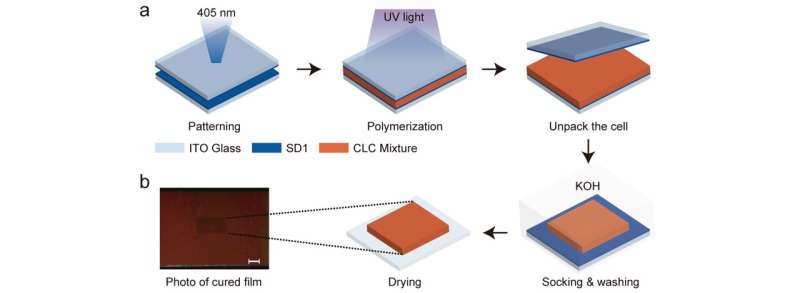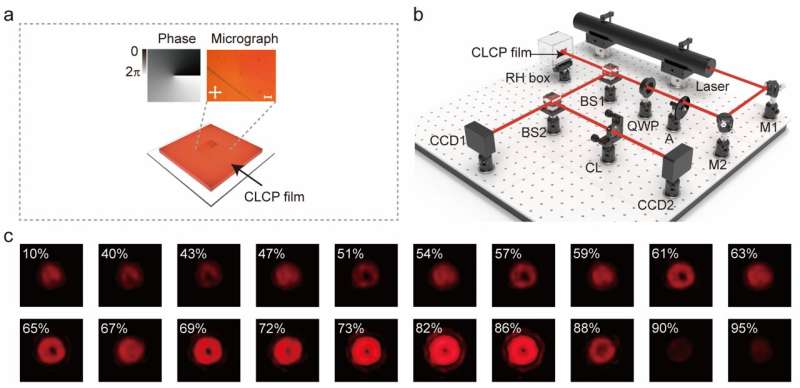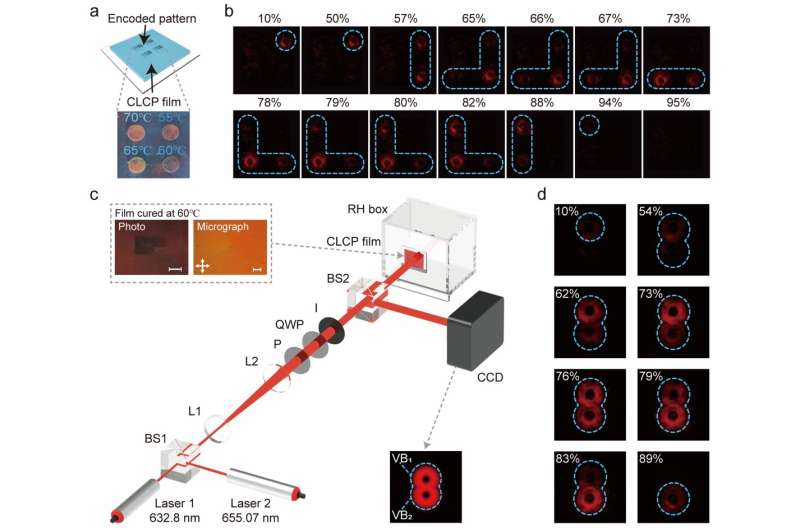This article has been reviewed according to Science X's editorial process and policies. Editors have highlighted the following attributes while ensuring the content's credibility:
fact-checked
peer-reviewed publication
trusted source
proofread
Geometric phase-encoded liquid crystal optical sensing

Sensing technology, integral to environmental monitoring, data acquisition, and precision data processing, is evolving rapidly. Researchers are at the forefront of developing swift, accessible, and cost-effective sensors. Among these innovations, cholesteric liquid crystals (CLCs) in stimulus-responsive photonic crystals exhibit exceptional promise.
Their unique helical structure and photonic properties enable the production of vivid, power-independent structural colors, paving the way for advanced visual analysis tools. However, a significant challenge hinders CLC's broader application in optical sensing: Although they visibly alter color in response to stimuli, accurately gauging these changes necessitates costly spectroscopic equipment, constraining their practical deployment.
Responding to the growing need for compact and planar optical elements, researchers have investigated Pancharatnam-Berry geometric phases, derived from light's spin-orbit interactions. Recent developments include integrating the geometric phase into reflected light via CLC helical superstructures, leading to novel photonic applications.
In CLC planar optics, this phase encoding alters the reflected light field across different wavebands, creating distinct visual patterns. This method surpasses traditional PBG wavelength/frequency sensing techniques. Additionally, the use of optical vortices (OV), which provide orbital angular momentum (OAM), has become pivotal in exploring tunable wavelength and OAM in vortex beams (VB).
To enhance sensing signal visualization, a team of researchers from Xiamen University and Nanjing University in China developed a cholesteric phase liquid crystal polymer (CLCP) visual sensing platform utilizing geometric phase coding.
This platform uniquely generates image-based sensing signals through real-time visual patterns, offering a more intuitive and readable alternative to conventional wavelength/frequency-based methods. The research is published in the journal Light: Science & Applications.

For proof-of-concept, the team demonstrated humidity detection using specially prepared CLCP films, composed of reactive liquid crystal monomers, photoinitiators, and chiral agents. As humidity increases, these films absorb water, expand, and undergo a pitch increase, leading to a reflective band's red-shift. This confirms CLCP's high humidity sensitivity, customizable response range, and excellent reversibility.
The team conducted an in-depth reflection diffraction analysis of humidity-responsive CLCP films, which encode a single q-plate, using a single-wavelength monitoring system. These experiments revealed that CLCP films can effectively translate changes in ambient humidity into visual signals. This finding underscores their suitability for real-time and long-range monitoring applications.
To broaden the humidity monitoring capabilities and detect trends, the researchers introduced two innovative approaches for studying the interaction between humidity and the geometrically phase-encoded CLCP films' reflected light (Fig. 3).

The first approach extended the monitoring range by incorporating a four-quadrant q-plate array onto the CLCP films. By UV curing each quadrant at different temperatures, distinct humidity ranges were achieved, correlating with variable VBs.
The second approach involved a dual-wavelength system, creating two VBs of different wavelengths. These VBs formed a dynamic "8" pattern, consisting of two "donut" shapes, responsive to humidity changes. These methods have proven effective in addressing the limitations of CLCP materials, enabling the monitoring of a broader humidity range and the detection of humidity trends.
This study introduces a novel CLCP optical sensing method using geometrical phase encoding, demonstrated through q-plate encoded humidity-responsive films. This technique allows for remote, non-contact humidity detection, creating VBs with clear "donut" patterns. It surpasses traditional liquid crystal sensing in accuracy, cost-efficiency, and commercial viability.
The approach is adaptable to various beam types, including Bessel and Airy beams, offering potential for anti-jamming capabilities and customizable visual patterns. Integrating machine learning for image-based sensing, this technique promises significant advancements in sensor technology.
Future integration with fiber optic technology is anticipated, paving the way for innovative environmental monitoring in communication and energy networks.
More information: Shi-Long Li et al, Geometric phase-encoded stimuli-responsive cholesteric liquid crystals for visualizing real-time remote monitoring: humidity sensing as a proof of concept, Light: Science & Applications (2024). DOI: 10.1038/s41377-023-01360-7
Journal information: Light: Science & Applications
Provided by Chinese Academy of Sciences




















